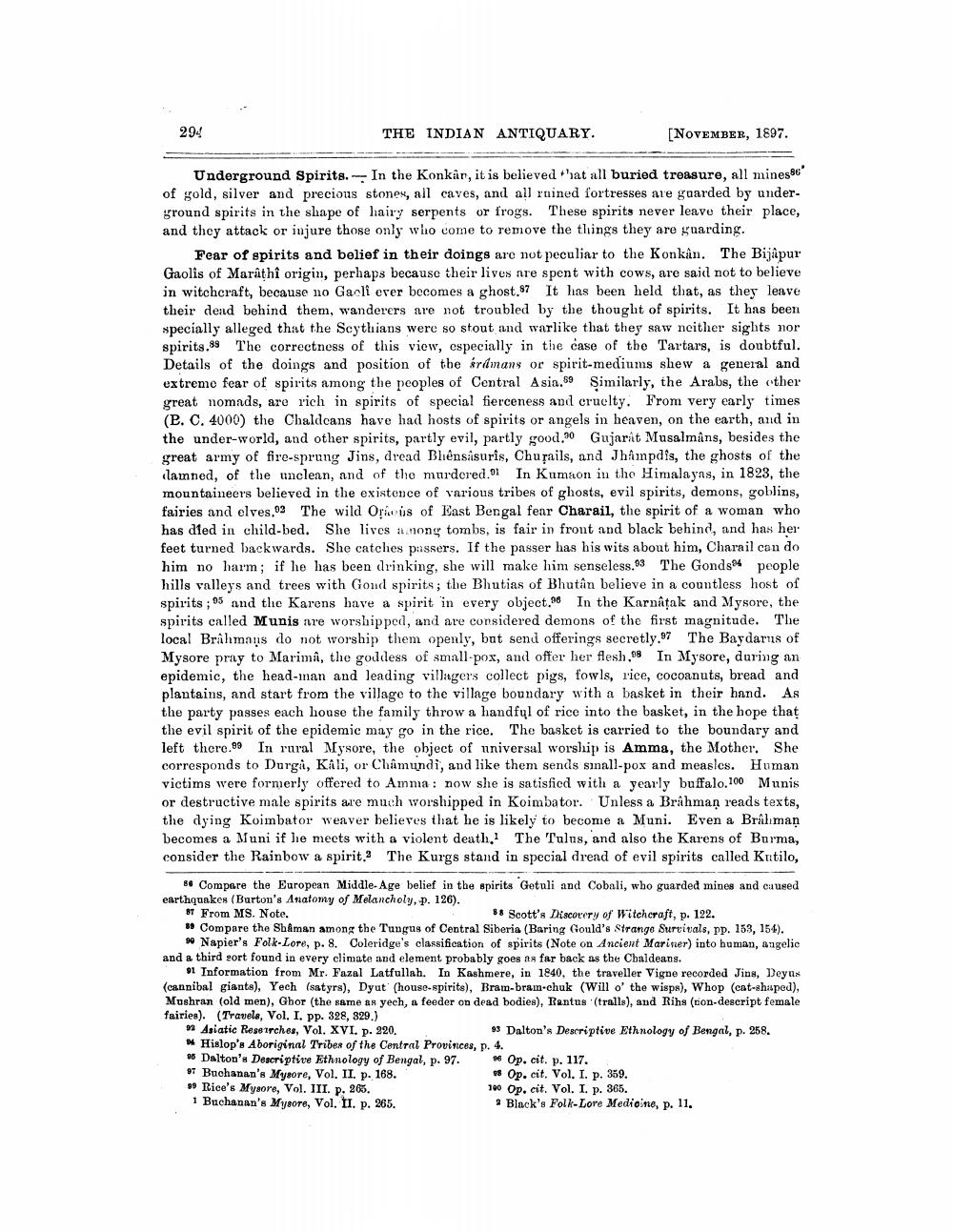________________
294
THE INDIAN ANTIQUARY.
[NOVEMBER, 1897.
Underground Spirits. In the Konkâr, it is believed that all buried treasure, all mines" of gold, silver and precious stones, all caves, and all ruined fortresses are guarded by underground spirits in the shape of hairy serpents or frogs. These spirits never leave their place, and they attack or injure those only who come to remove the things they are guarding.
Fear of spirits and belief in their doings are not peculiar to the Konkân. The Bijapur Gaolis of Marathî origin, perhaps because their lives are spent with cows, are said not to believe in witchcraft, because no Gaeli ever becomes a ghost.87 It has been held that, as they leave their dead behind them, wanderers are not troubled by the thought of spirits. It has been specially alleged that the Scythians were so stout and warlike that they saw neither sights nor spirits. The correctness of this view, especially in the case of the Tartars, is doubtful. Details of the doings and position of the ardmans or spirit-mediums shew a general and extreme fear of spirits among the peoples of Central Asia.59 Similarly, the Arabs, the other great nomads, are rich in spirits of special fierceness and cruelty. From very early times (P. C. 4000) the Chaldeans have had hosts of spirits or angels in heaven, on the earth, and in the under-world, and other spirits, partly evil, partly good.20 Gujarat Musalmâns, besides the great army of fire-sprung Jins, dread Bhiênsâsuris, Churails, and Jhimpdis, the ghosts of the damned, of the unclean, and of the murdered. In Kumaon in the Himalayas, in 1823, the mountaineers believed in the existence of various tribes of ghosts, evil spirits, demons, goblins, fairies and elves.92 The wild Orious of East Bengal fear Charail, the spirit of a woman who has died in child-bed. She lives anong tombs, is fair in front and black behind, and has her feet turned backwards. She catches passers. If the passer has his wits about him, Charail can do him no harm; if he has been drinking, she will make him senseless.93 The Gonds people hills valleys and trees with Gond spirits; the Bhutias of Bhutan believe in a countless host of spirits; 95 and the Karens have a spirit in every object.98 In the Karnatak and Mysore, the spirits called Munis are worshipped, and are considered demons of the first magnitude. The local Brahmaus do not worship them openly, but send offerings secretly.97 The Baydarus of Mysore pray to Marimâ, the goddess of small-pox, and offer her flesh,98 In Mysore, during an epidemic, the head-man and leading villagers collect pigs, fowls, rice, cocoanuts, bread and plantains, and start from the village to the village boundary with a basket in their hand. As the party passes each house the family throw a handful of rice into the basket, in the hope that the evil spirit of the epidemic may go in the rice. The basket is carried to the boundary and left there.99 In rural Mysore, the object of universal worship is Amma, the Mother. She corresponds to Durga, Kali, or Chamundi, and like them sends small-pox and measles. Human victims were formerly offered to Amma: now she is satisfied with a yearly buffalo.100 Munis or destructive male spirits are much worshipped in Koimbator. Unless a Brahman reads texts, the dying Koimbator weaver believes that he is likely to become a Muni. Even a Brahman becomes a Muni if he meets with a violent death. The Tulus, and also the Karens of Burma, consider the Rainbow a spirit. The Kurgs stand in special dread of evil spirits called Kutilo,
86 Compare the European Middle-Age belief in the spirits Getuli and Cobali, who guarded mines and caused earthquakes (Burton's Anatomy of Melancholy, p. 126).
87 From MS. Note.
88 Scott's Discovery of Witchcraft, p. 122.
* Compare the Shaman among the Tungus of Central Siberia (Baring Gould's Strange Survivals, pp. 153, 154). Napier's Folk-Lore, p. 8. Coleridge's classification of spirits (Note on Ancient Mariner) into human, angelic and a third sort found in every climate and element probably goes as far back as the Chaldeans.
91 Information from Mr. Fazal Latfullah. In Kashmere, in 1840, the traveller Vigne recorded Jins, Deyns (cannibal giants), Yech (satyrs), Dyut (house-spirits), Bram-bram-chuk (Will o' the wisps), Whop (cat-shaped), Mushran (old men), Ghor (the same as yech, a feeder on dead bodies), Rantus (tralls), and Rihs (non-descript female fairies). (Travels, Vol. I. pp. 328, 329.)
92 Asiatic Researches, Vol. XVI. p. 220.
Hislop's Aboriginal Tribes of the Central Provinces,
15 Dalton's Descriptive Ethnology of Bengal, p. 97.
97 Buchanan's Mysore, Vol. II. p. 168.
99 Rice's Mysore, Vol. III. p. 265.
1 Buchanan's Mysore, Vol. II. p. 265.
93 Dalton's Descriptive Ethnology of Bengal, p. 258. p. 4.
se Op. cit. p. 117.
18 Op. cit. Vol. I. p. 359.
100 Op. cit. Vol. I. p. 365.
2 Black's Folk-Lore Medioine, p. 11.




